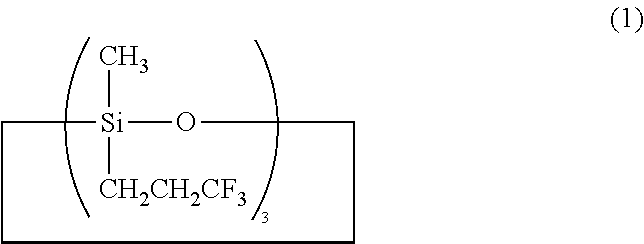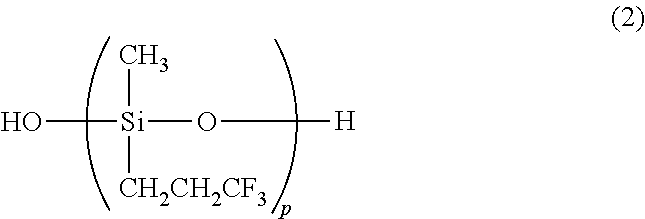Preparation of triorganosiloxy end-capped organopolysiloxane
a technology of end caps and organopolysiloxane, which is applied in the field of preparation of triorganosiloxy end caps organopolysiloxane, can solve the problems of reducing the purity of end groups, difficult to control molecular weight and viscosity, and hexaorganodisilazane alone is not regarded as ensuring, etc., and achieves easy control of molecular weight, improved vulcanization properties, and easy removal
- Summary
- Abstract
- Description
- Claims
- Application Information
AI Technical Summary
Benefits of technology
Problems solved by technology
Method used
Image
Examples
example 1
Synthesis of Fluorosilicone Polymer I
[0054]A 1-L separable flask was charged with 461.03 g (0.99 mole) of tris(3,3,3-trifluoropropyl)trimethylcyclotrisiloxane and 36.72 g (0.0082 mole) of a silanol end-capped organopolysiloxane of the average molecular formula (7):
and heated at 150° C. under a nitrogen gas atmosphere. With stirring, 0.25 g (0.00045 mole) of a siloxane oligomer of an organolithium compound having the formula (8):
was added, whereupon polymerization reaction was run at 150° C. for 6 hours to form an organopolysiloxane. After cooling to 100° C., a mixed solution of 0.56 g (0.0024 mole) of dimethylvinylsilyl triflate and 3.41 g (0.018 mole) of 1,3-divinyltetramethyldisilazane was added to the organopolysiloxane. Stirring was continued for 3 hours at 100° C. whereby the siloxane oligomer of an organolithium compound (lithium silanolate catalyst) was neutralized and the siloxane polymer was end-capped with dimethylvinylsiloxy groups at the same time. By vacuum stripping at...
example 2
Synthesis of Fluorosilicone Polymer II
[0055]A 5-L separable flask was charged with 2811.2 g (6.01 mole) of tris(3,3,3-trifluoropropyl)trimethylcyclotrisiloxane and 223.9 g (0.05 mole) of a silanol end-capped organopolysiloxane of the average molecular formula (7) and heated at 150° C. under a nitrogen gas atmosphere. With stirring, 1.52 g (0.0027 mole) of a siloxane oligomer of an organolithium compound having the formula (8) was added, whereupon polymerization reaction was run at 150° C. for 6 hours to form an organopolysiloxane. After cooling to 100° C., 0.82 g (0.0055 mole) of trifluoromethanesulfonic acid was added to the organopolysiloxane. Stirring was continued for 30 minutes whereby the siloxane oligomer of an organolithium compound was neutralized. Then 20.43 g (0.11 mole) of 1,3-divinyltetramethyldisilazane was added to the organopolysiloxane. Stirring was continued for 3 hours at 100° C. whereby the siloxane polymer was end-capped with dimethylvinylsiloxy groups. By vacuu...
PUM
| Property | Measurement | Unit |
|---|---|---|
| temperature | aaaaa | aaaaa |
| time | aaaaa | aaaaa |
| time | aaaaa | aaaaa |
Abstract
Description
Claims
Application Information
 Login to View More
Login to View More - R&D
- Intellectual Property
- Life Sciences
- Materials
- Tech Scout
- Unparalleled Data Quality
- Higher Quality Content
- 60% Fewer Hallucinations
Browse by: Latest US Patents, China's latest patents, Technical Efficacy Thesaurus, Application Domain, Technology Topic, Popular Technical Reports.
© 2025 PatSnap. All rights reserved.Legal|Privacy policy|Modern Slavery Act Transparency Statement|Sitemap|About US| Contact US: help@patsnap.com



